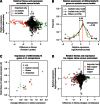Indirect and suboptimal control of gene expression is widespread in bacteria
- PMID: 23591776
- PMCID: PMC3658271
- DOI: 10.1038/msb.2013.16
Indirect and suboptimal control of gene expression is widespread in bacteria
Abstract
Gene regulation in bacteria is usually described as an adaptive response to an environmental change so that genes are expressed when they are required. We instead propose that most genes are under indirect control: their expression responds to signal(s) that are not directly related to the genes' function. Indirect control should perform poorly in artificial conditions, and we show that gene regulation is often maladaptive in the laboratory. In Shewanella oneidensis MR-1, 24% of genes are detrimental to fitness in some conditions, and detrimental genes tend to be highly expressed instead of being repressed when not needed. In diverse bacteria, there is little correlation between when genes are important for optimal growth or fitness and when those genes are upregulated. Two common types of indirect control are constitutive expression and regulation by growth rate; these occur for genes with diverse functions and often seem to be suboptimal. Because genes that have closely related functions can have dissimilar expression patterns, regulation may be suboptimal in the wild as well as in the laboratory.
Conflict of interest statement
The authors declare that they have no conflict of interest.
Figures





Comment in
-
Bacterial physiology: Unfit expression.Nat Rev Microbiol. 2013 Jun;11(6):362. doi: 10.1038/nrmicro3035. Epub 2013 May 8. Nat Rev Microbiol. 2013. PMID: 23652325 No abstract available.
Similar articles
-
Evidence-based annotation of gene function in Shewanella oneidensis MR-1 using genome-wide fitness profiling across 121 conditions.PLoS Genet. 2011 Nov;7(11):e1002385. doi: 10.1371/journal.pgen.1002385. Epub 2011 Nov 17. PLoS Genet. 2011. PMID: 22125499 Free PMC article.
-
Towards an informative mutant phenotype for every bacterial gene.J Bacteriol. 2014 Oct;196(20):3643-55. doi: 10.1128/JB.01836-14. Epub 2014 Aug 11. J Bacteriol. 2014. PMID: 25112473 Free PMC article.
-
Transcriptional and proteomic analysis of a ferric uptake regulator (fur) mutant of Shewanella oneidensis: possible involvement of fur in energy metabolism, transcriptional regulation, and oxidative stress.Appl Environ Microbiol. 2002 Feb;68(2):881-92. doi: 10.1128/AEM.68.2.881-892.2002. Appl Environ Microbiol. 2002. PMID: 11823232 Free PMC article.
-
Transcriptome analysis reveals response regulator SO2426-mediated gene expression in Shewanella oneidensis MR-1 under chromate challenge.BMC Genomics. 2008 Aug 21;9:395. doi: 10.1186/1471-2164-9-395. BMC Genomics. 2008. PMID: 18718017 Free PMC article.
-
Genome-assisted analysis of dissimilatory metal-reducing bacteria.Curr Opin Biotechnol. 2005 Jun;16(3):269-74. doi: 10.1016/j.copbio.2005.04.001. Curr Opin Biotechnol. 2005. PMID: 15961027 Review.
Cited by
-
Redefining fundamental concepts of transcription initiation in bacteria.Nat Rev Genet. 2020 Nov;21(11):699-714. doi: 10.1038/s41576-020-0254-8. Epub 2020 Jul 14. Nat Rev Genet. 2020. PMID: 32665585 Free PMC article. Review.
-
Temporal order and precision of complex stress responses in individual bacteria.Mol Syst Biol. 2019 Feb 14;15(2):e8470. doi: 10.15252/msb.20188470. Mol Syst Biol. 2019. PMID: 30765425 Free PMC article.
-
Proteomic survey of the DNA damage response in Caulobacter crescentus.J Bacteriol. 2023 Oct 26;205(10):e0020623. doi: 10.1128/jb.00206-23. Epub 2023 Sep 20. J Bacteriol. 2023. PMID: 37730540 Free PMC article.
-
Exploring the roles of DNA methylation in the metal-reducing bacterium Shewanella oneidensis MR-1.J Bacteriol. 2013 Nov;195(21):4966-74. doi: 10.1128/JB.00935-13. Epub 2013 Aug 30. J Bacteriol. 2013. PMID: 23995632 Free PMC article.
-
Transcript level and sequence determinants of protein abundance and noise in Escherichia coli.Nucleic Acids Res. 2014 Apr;42(8):4791-9. doi: 10.1093/nar/gku126. Epub 2014 Feb 7. Nucleic Acids Res. 2014. PMID: 24510099 Free PMC article.
References
-
- Bremer H, Dennnis PP (1996) Modulation of chemical composition and other parameters of the cell by growth rate. In Escherichia coli and Salmonella typhimurium: Cellular and Molecular Biology Washington, DC: American Society for Microbiology2nd edn pp 1553–1569
Publication types
MeSH terms
Substances
LinkOut - more resources
Full Text Sources
Other Literature Sources
Molecular Biology Databases

